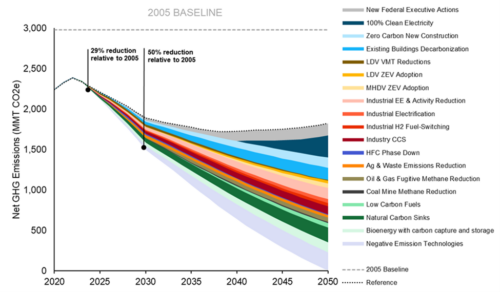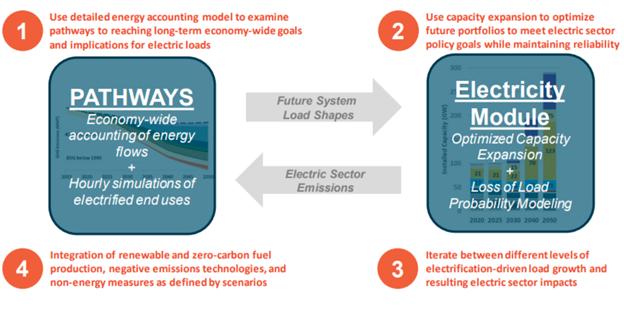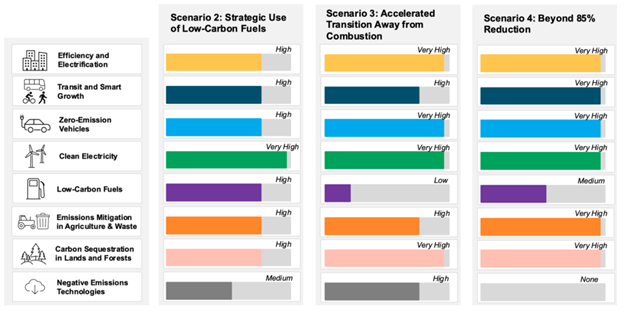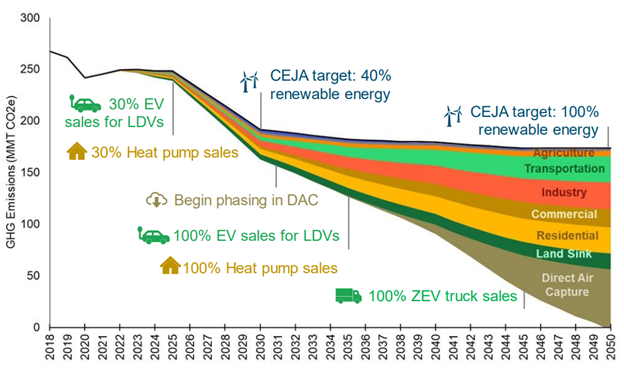E3’s PATHWAYS model helps clients plan for and achieve economy-wide decarbonization. It identifies greenhouse gas reduction measures from transportation, buildings, industry, electricity, and other sectors, and captures interactions among measures to create a detailed picture of emissions reductions and costs through 2050.

PATHWAYS analysis of annual GHG emissions reductions by measure for a US Climate Alliance net-zero by 2050 scenario.
As a “stock rollover” model, PATHWAYS considers realistic timing of investments to replace appliances, vehicles, buildings, and other infrastructure. It pays special attention to the dynamics between electricity generation and new loads from transportation and buildings, as well as the role of low-carbon fuels such as advanced biofuels, hydrogen, and synthetic fuels, and potential for negative emissions from land use and technology-based sinks such as direct air capture of CO2. PATHWAYS also calculates costs (e.g., electric vehicles, heat pumps, hydrogen expenditures) and benefits (e.g., avoided health impacts, social costs of GHGs) of decarbonization scenarios.
Originally developed in 2008, PATHWAYS has performed several groundbreaking studies, including an analysis of the technology path to deep, long-term emissions cuts that appeared in the journal Science and a U.S.-wide study for the 2015 United Nations Climate Change Conference (COP 21).
PATHWAYS is the analytical engine behind the California Energy Commission’s landmark 2018 study of deep decarbonization in a high renewables future and the Scoping Plans from the California Air Resources Board (2017, 2022) and New York (2023) that support achieving net zero futures.
For projects that require a detailed assessment of the role of the electricity sector, we pair PATHWAYS with E3’s RESOLVE model. Recent projects include New York’s Scoping Plan, Illinois Decarbonization Study, Hawai’i Pathways to Decarbonization, and Xcel Energy’s resource planning and corporate climate strategy.

Modeling linkages from PATHWAYS to RESOLVE
PATHWAYS has been increasingly used to inform strategy for future of gas distribution, for example in Massachusetts, Maryland, and Rhode Island.
The tool is customized for each engagement to reflect state and regional greenhouse gas emissions and specific client needs. In addition to benchmarking our models to the most recent data sets, we work with clients to develop scenarios that answer the right questions for each study.

Net zero scenario design for New York’s 2023 Final Scoping Plan
We are increasingly linking our PATHWAYS model to other more detailed tools such as customer affordability, equity and disadvantaged community impacts, health impacts, customer adoption and incentive design, electrification load shaping, impacts of flexible loads, low-carbon fuel supply curves, and geospatial mapping of electrification demands on the electric distribution system.
Milestones in decarbonizing the Illinois economy

Milestones in reducing Illinois emissions to net zero by 2050 in a High Electrification scenario, as modeled by E3’s PATHWAYS model. (Source: E3, “Illinois Decarbonization Study: Climate and Equitable Jobs Act and Net Zero by 2050,” 2022.)
All Tools


